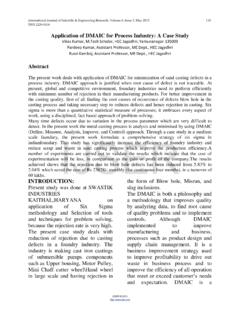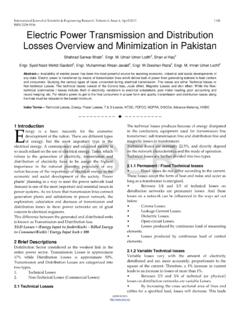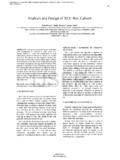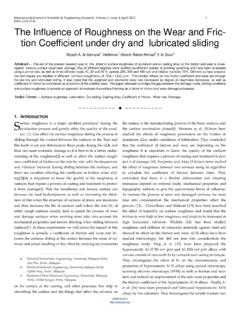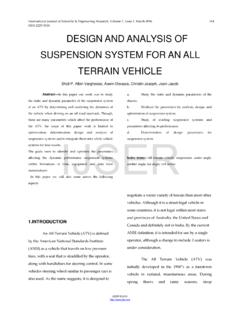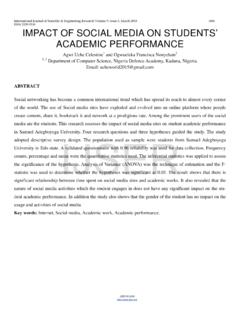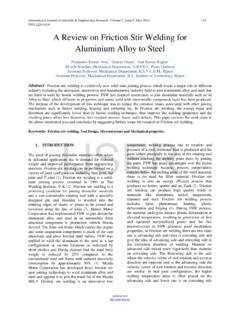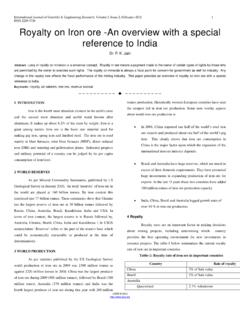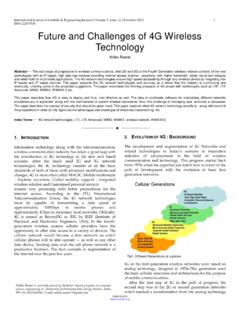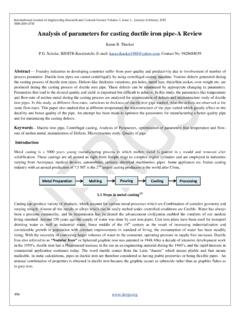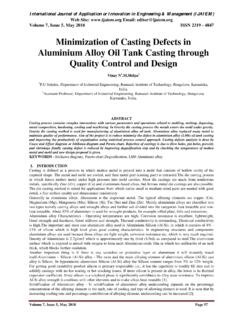Transcription of Minimization of Defect in Aluminium Alloy Wheel …
1 International Journal of Scientific & Engineering Research, Volume 7, Issue 3, March-2016 744 ISSN 2229-5518 IJSER 2016 Minimization of Defect in Aluminium Alloy Wheel casting Using 7 QC Tools Prashant k. Sharma1, Ankit Jain2, Pankaj Bisht3 1,2 SDGI Ghaziabad, 3 BPKIT Dwarahat Abstract: W ith the increasing use of aluminum wheels in automotive industry, the aluminum foundry industry had to focus on the quality and reliability of the products. To produce good quality aluminum cast wheels, defects must be minimized. Aim of the current study is to study defects of an aluminum Alloy casting and to improve the quality of casting using quality control tools.
2 This study shows the systematic approach to find the root cause of a major defects in Aluminium castings using Defect diagnostic approach as well as cause and effect diagram. casting Defect analysis is carried out using techniques like historical data analysis, cause-effect diagrams, design of experiments and root cause analysis. Data from X-ray inspection (Radiographic Inspection) have been collected along with the production parameter data. Using Pareto chart major defects in the Aluminium castings were noted. The major defects for the rejections during production were identified as shrinkages, inclusions, porosity/gas holes and cracks. Each Defect is studied thoroughly and the possible causes for the defects are shown in Fishbone Diagrams (Cause Effect Diagrams).
3 As the shrinkages mainly occur due to lack of feedability during the fluid flow the stalk changing frequency is noted along with the shrinkages defects and a relation is drawn between them. As hydrogen forms gas holes and porosity in the Aluminium castings the amount of hydrogen present in the molten metal is studied by finding specific gravity of the samples collected. The molten metal temperature effects the amount of the hydrogen absorbed by it..So the effect of molten metal temperature on the specific gravity of the sample collected have been shown in a graph and the optimum value for molten metal temperature was found out. 1. Introduction The use of aluminum castings in the automotive industry has increased incredibly over the past two decades.
4 The driving force for this increased use is vehicle weight reduction for improved performance, particularly fuel efficiency. In many cases, the mechanical properties of the cast aluminum parts are superior to those of the cast iron or wrought steel parts being replaced. For the production of aluminum Alloy Wheel , Al-Si casting alloys are mostly used as the raw material. Because of their good casting properties, this type of allo ys provides the Alloy Wheel to have good corrosion resistance and strength so that the vehicle can adapt to the road and weather conditions. The main alloying elements of Al-Si castings are silicon, magnesium, iron, manganese, beryllium, zinc, strontium and titanium.
5 Each element gives some special features to the casting Alloy so that the Alloy can be produced with desired properties. The compositions of these elements affect the final properties. Aluminum casting Alloy wheels are generally produced using low-pressure die- casting . For the application of this casting method, Al-Si casting alloys should be chosen owing to their high adaptation capabilit y to the permanent metal mo lds. By the help of alloying elements, it is possible to achieve effective and efficient aluminum Alloy Wheel production. Aluminum allo y wheels have important advantages compared to the steel wheels. advantages provide aluminum Alloy Wheel to be popular.
6 However, in production of wheels, defects in the cast microstructure undermine performance characteristics. IJSERI nternational Journal of Scientific & Engineering Research, Volume 7, Issue 3, March-2016 745 ISSN 2229-5518 IJSER 2016 Quality improvement of aluminum Alloy Wheel production facilitates understanding the process parameters and their influences on the Defect formation. To decrease the amount of scrap and rework, satisfactory quality of the production has to be achieved. This can be done using quality improvement tools. Controlling process parameters can decrease defects on aluminum Alloy Wheel and the amount of scrap produced.
7 In this study, defects on aluminum Alloy Wheel were investigated by means of real time radioscopic method and minimize using quality control tools. 2. Theory and literature survey Al-Si Cast ing Allo ys Aluminum cast alloys have been developed for casting qualities such as feeding ability and fluidit y, as well as for mechanical properties such as strength, ductility, and corrosion resistance. Thus, their chemical compositions differ widely from those of the wrought aluminum alloys Because pure aluminum is a relatively poor casting material, aluminum casting is actually made of an aluminum allo y. The most important aluminum cast ing allo ys are [1,3,4] aluminum-copper, aluminum-silicon, aluminum-zinc and aluminum-magnesium casting alloys .
8 Aluminum casting alloys with silicon as the major alloying element are the most important commercial casting alloys because of their superior casting characteristics. Aluminum-silicon alloys have comparatively high fluidity in the molten state, excellent feeding during solidification, and comparative freedo m fro m hot shortness. Silicon does not reduce the good corrosion resistance of pure aluminum, and in some cases increases its corrosion resistance in mild acidic environment. Alloy Type Application Bracket housings, internal engine parts Blocks, transmission housing-parts, fu el metering devices Manifolds, cylinder heads, blocks, internal engine parts Cylinder heads, manifolds Wheels High wear applications such as ring gears and internal transmission parts Table 1.
9 Typical applications of the Al-Si Alloy [6] Element Silicon Iron Copper Manganese Magnesium .50 ..20 .. Chromium Nickel Zinc Titanium All others Aluminum Remainder Remainder Remainder Remainder Remainder Remainder Table 2. Chemical composition( limits of LPPM Al-Si casting alloys [22]) Types of allo ys IJSERI nternational Journal of Scientific & Engineering Research, Volume 7, Issue 3, March-2016 746 ISSN 2229-5518 IJSER 2016 The types of Al Alloy wheels are given below.
10 1. Forged Al Allo y Wheels 2. Single piece Al Alloy Wheels 3 Mult i piece Al Allo y Wheels Forged Al Alloy wheels are generally used in medium and heavy trucks. A forged Al Wheel is shown in Figure 1. Forged wheels are manufactured by using one piece of aluminum Alloy that gives fuel savings, greater payloads and lower weight. Most Al wheels are single-piece castings manufactured from a variety of casting processes ( ). The cast product provides an infinite number of styling iterations and optimized for minimum weight and cost. This type of wheels can be used in passenger cars, minivans, sport utility vehicles and etc. Multi piece wheels are actually manufactured from two or more components that are securely welded together.
